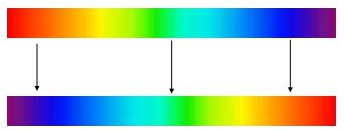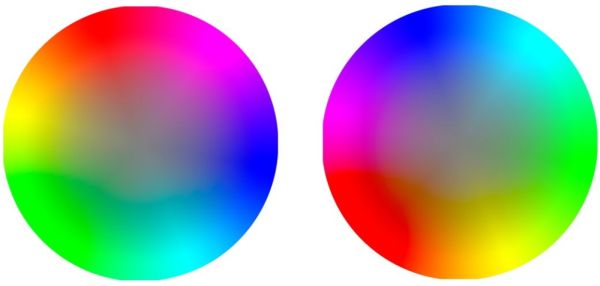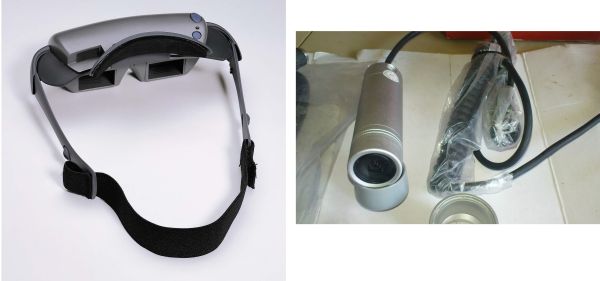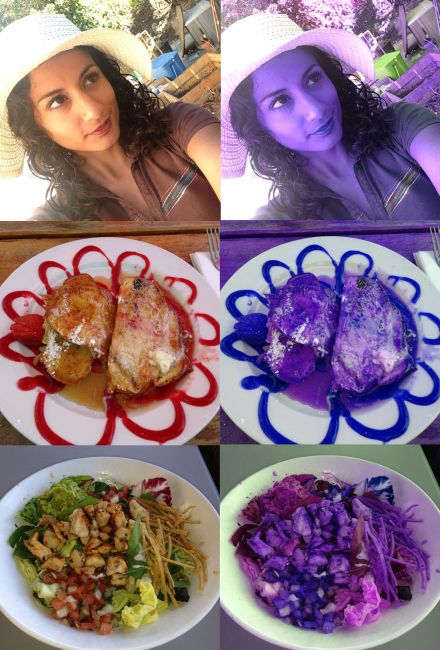1 Introduction
The idea of a subject whose visual experience is color inverted has been a philosophical mainstay at least since Locke (1975), and has fuelled a great deal of philosophical work on the nature of perception up to the present day. In psychology, testing the extent to which subjects’ visual systems can adapt to alterations in visual input has likewise been a fruitful mainstay for over a century (for current research and references see Heuer & Hegele 2008; Heuer & Rapp 2011; Belmore & Shevell 2011). Despite these two facts, adaptation to an inverted spectrum has never been studied. Given that there is adaptation to a wide range of distortions to visual input, including spatial manipulations and spectral filtering, we speculated that it was conceivable that there might be adaptation, in some form or other, to color rotation. That is, if visual input was reworked such that tomatoes appeared blue, would subjects over time adapt so that tomatoes regained their normal (red) phenomenal appearance? And even if such a shocking result did not occur, might there nevertheless be adaptation to other color-relevant phenomena, such as color constancy, aesthetic judgments, or the memory-color effect?
 Figure 1: An inverted spectrum. The familiar red-to-violet spectrum laid out from left to right (top) compared to an inverted violet-to-red spectrum from left to right (bottom). Note that the central colors map to themselves or very similar colors.
Figure 1: An inverted spectrum. The familiar red-to-violet spectrum laid out from left to right (top) compared to an inverted violet-to-red spectrum from left to right (bottom). Note that the central colors map to themselves or very similar colors.
We tested this as follows. First, rather than an inverted spectrum, we employed a rotated spectrum. An inverted spectrum is one in which one takes the usual red-to-violet spectrum and just reverses it to get a mapping from colors to colors. Red would map to violet, orange to blue, violet to red, and so on (see figure 1).
For two reasons we chose to systematically alter color input not with an inverted spectrum, but with color rotation (see figure 2). In a 120° degree rotation, greens become reds, reds become blues, and blues become greens (see figure 3).
One reason to employ a rotation rather than an inversion is that in a rotation, all colors map to different colors, whereas in a spectral inversion, the middle of the spectrum maps to itself, and so not all colors differ. Also, with a 120° rotation, primary colors map to primary colors, and this was convenient for testing purposes. For instance, we wanted to test semantic adaptation via a Stroop task, and Stroop is difficult to test if one is dealing with non-canonical colors (since subjects pause to think of what seems to be the best name for the color: “… um, periwinkle?”). It was important that the text was colored in a primary color during baseline testing (before subjects’ vision was color-altered), and that it continued to be presented in a primary color during testing while colors were altered.
 Figure 2: Color rotation. If colors on the left disk are mapped to colors that are 1/3 of a clockwise rotation (120º), then green (lower left) maps on to red (slightly left of the top); red maps to blue (middle right); and so forth. The disk on the right is a 120º color-rotated version of the disk on the left.
Figure 2: Color rotation. If colors on the left disk are mapped to colors that are 1/3 of a clockwise rotation (120º), then green (lower left) maps on to red (slightly left of the top); red maps to blue (middle right); and so forth. The disk on the right is a 120º color-rotated version of the disk on the left.
The rotation was implemented in the following way. A small video camera was mounted on a bike helmet, as were a pair of LCD goggles (see figure 4). The sides of the goggles were sealed against the wearer’s face so that there was no peripheral visual input; subjects could only see what was displayed on the LCDs. The video camera output was run to a laptop computer, which ran software that color-rotated the video feed and pushed the result to the LCD goggles. The subject would wear the bike helmet and carry a bag that held the laptop and battery packs for the laptop, camera, and goggles. In what follows we will refer to this as the rotation gear, or simply the gear. Moreover, we will use the expression under rotation to refer to the condition of having one’s visual input color-rotated by the gear. In addition to rotating the spectrum (the intentional effect), the gear also eliminated binocular disparity since there was only one camera (which projected the same image to both eyes), and also impaired peripheral vision, since the camera’s field of view was less than normal vision. As a result, while most normal activities were possible (if cumbersome), some, such as driving a motor vehicle, were not possible.
Figure 3: A typical outdoor scene color-rotated by 120º. Click here to see the video (required on some eBook-Readers and for Google Chrome).
There were only two subjects, and both were investigators in this project (and authors of this paper). This was for practical reasons. First, we anticipated that UCSD Internal Review Board would be reluctant to grant human subjects approval, based both on the length and significant inconvenience of the protocol and also because this particular protocol had never been attempted before, and so, for example, there was no precedent concerning whether such a regimen might cause long-term damage to participants’ color vision. And even if approval were obtained, we anticipated that finding volunteers for such a protocol would be difficult, and, even if we did find them, the small grant we were operating with did not give us the resources to appropriately compensate them. Employing two of the investigators as subjects solved these problems. Because investigators were aware of the protocol and risks, and were intimately familiar with the relevant equipment and potential problems and so in a position to more accurately assess conditions under which the protocol should be aborted, some of the concerns were eased, and approval was eventually granted. Moreover, investigators were willing to put themselves through the arduous protocol.
Subject 1 (RG) wore the gear intermittently, in several multi-hour sessions per day for a week. Two reasons for an initial intermittent protocol were, first, that it would allow us to trouble-shoot the equipment—if it had to be shut down for a few hours for tinkering this would not interfere with the protocol, and we wanted to ensure that everything was functioning smoothly before subject JK’s continuous protocol began. And, second, we wanted to compare the results of a subject who wore the gear intermittently with the results of one who wore it continually. Subject JK wore the gear continually for six straight days, meaning that he had no unrotated visual input for that entire period. He slept with a blindfold and showered with closed eyes in the dark, but otherwise wore the gear at all times.
 Figure 4: The camera and goggles used.
Figure 4: The camera and goggles used.
Our high-level goals were to assess phenomenal and semantic adaptation. Phenomenal adaptation would manifest as a return to normalcy such that under rotation tomatoes would start to look red again, the sky would appear blue, and so forth (this is discussed in more detail later on). It might also manifest as a gaining of color constancy under rotation. These would be parallel to adaptation to spatial inversion in which, after adaptation objects begin to look right-side-up again. We assessed this in several ways. One was the memory-color effect. A second was aesthetic judgments. A final method was subjective report: subject JK kept a hard-copy journal in which he wrote observations, and RG had a digital voice recorder that he used for similar purposes. There were also audio recordings made during the testing periods, as well as when JK finally removed the rotation-gear.
Semantic adaptation would manifest as a remapping of color terms to their “correct” referents. So, for example, when first putting on the gear, if a subject were asked to pick up the “blue block,” they would pick up a block that was in fact red. Would subjects semantically adapt such that the word “red” was immediately semantically connected to the red block, despite the fact that the block was presented as blue through the rotation gear? This was assessed via subjective report and Stroop. In the following sections we discuss each investigated phenomenon, the results we found, and their implications.
For all experiments there were four times at which trials were run: i) pre-rotation, in which trials were run after the subject initially put on the gear but the colors were not yet rotated; ii) early rotation, wearing the gear and first color-rotating visual input; iii) late rotation, at the end of the time during which the subject was wearing the gear and had time to adapt; and iv) post-rotation, while the subject was still wearing the gear, but colors were not rotated. The reason for running trials (i) and (iv) while wearing the gear without rotating the colors, rather than just through normal vision without the gear, was to control for effects possibly due only to the fact that visual input was going through a camera and LCD goggles. For some experiments there were additional times at which the trials were run, as will be explained below.
A final note on methodology. A number of factors distinguish the current study from an appropriately run and controlled psychological experiment. The small n and the fact that both subjects were also investigators in the study are perhaps the two most significant differences. These limitations were forced by a variety of factors, including the unusual degree of hardship faced by subjects, our relatively small budget, and the fact that this protocol had never been tried before. Because of these limitations, the experiments and results we report here are intended to be taken only as preliminary results—as something like a pilot study. Even so, the results, we believe, are quite interesting and suggestive.
 Figure 5: Images of people and food, in normal color, and with a 120º color rotation, for purposes of illustration only—none of these was in the stimuli set used in the experiment. The food items are French toast with maple syrup and strawberry confit (middle row), and chicken salad with guacamole (bottom).
Figure 5: Images of people and food, in normal color, and with a 120º color rotation, for purposes of illustration only—none of these was in the stimuli set used in the experiment. The food items are French toast with maple syrup and strawberry confit (middle row), and chicken salad with guacamole (bottom).